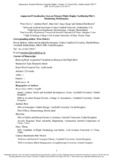JavaScript is disabled for your browser. Some features of this site may not work without it.
| dc.contributor.author | Li, Wen-Chin | |
| dc.contributor.author | Horn, Andreas | |
| dc.contributor.author | Sun, Zhen | |
| dc.contributor.author | Zhang, Jingyi | |
| dc.contributor.author | Braithwaite, Graham | |
| dc.date.accessioned | 2019-11-19T16:45:54Z | |
| dc.date.available | 2019-11-19T16:45:54Z | |
| dc.date.issued | 2019-11-14 | |
| dc.identifier.citation | Li W-C, Horn A, Sun Z, et al., (2020). Augmented visualization cues on primary flight display facilitating pilot's monitoring performance. International Journal of Human-Computer Studies, Volume 135, March 2020, Article number 102377 | en_UK |
| dc.identifier.issn | 1071-5819 | |
| dc.identifier.uri | https://doi.org/10.1016/j.ijhcs.2019.102377 | |
| dc.identifier.uri | https://dspace.lib.cranfield.ac.uk/handle/1826/14748 | |
| dc.description.abstract | There have been many aviation accidents and incidents related to mode confusion on the flight deck. The aim of this research is to evaluate human-computer interactions on a newly designed augmented visualization Primary Flight Display (PFD) compared with the traditional design of PFD. Based on statistical analysis of 20 participants interaction with the system, there are significant differences on pilots’ pupil dilation, fixation duration, fixation counts and mental demand between the traditional PFD design and augmented PFD. The results demonstrated that augmented visualisation PFD, which uses a green border around the “raw data” of airspeed, altitude or heading indications to highlight activated mode changes, can significantly enhance pilots’ situation awareness and decrease perceived workload. Pilots can identify the status of flight modes more easily, rapidly and accurately compared to the traditional PFD, thus shortening the response time on cognitive information processing. This could also be the reason why fixation durations on augmented PFDs were significantly shorter than traditional PFDs. The augmented visualization in the flight deck improves pilots’ situation awareness as indicated by increased fixation counts related to attention distribution. Simply highlighting the parameters on the PFD with a green border in association with relevant flight mode changes will greatly reduce pilots’ perceived workload and increase situation awareness. Flight deck design must focus on methods to provide pilots with enhanced situation awareness, thus decreasing cognitive processing requirements by providing intuitive understanding in time limited situations. | en_UK |
| dc.language.iso | en | en_UK |
| dc.publisher | Elsevier | en_UK |
| dc.rights | Attribution-NonCommercial-NoDerivatives 4.0 International | * |
| dc.rights.uri | http://creativecommons.org/licenses/by-nc-nd/4.0/ | * |
| dc.subject | Augmented Visualization | en_UK |
| dc.subject | Attention Distribution | en_UK |
| dc.subject | Flight Deck Design | en_UK |
| dc.subject | Situation Awareness | en_UK |
| dc.subject | Human-Computer Interaction | en_UK |
| dc.title | Augmented visualization cues on primary flight display facilitating pilot's monitoring performance | en_UK |
| dc.type | Article | en_UK |
| dc.identifier.cris | 25326475 |
Files in this item
The following license files are associated with this item:
This item appears in the following Collection(s)
-
Staff publications (SATM) [4360]

